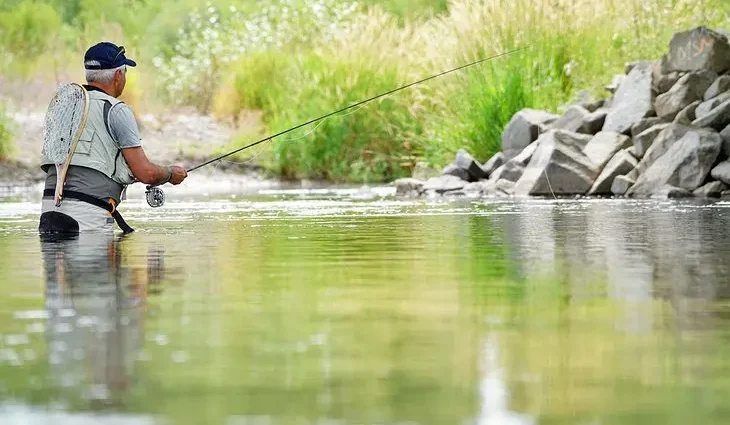Contents
Nothing speaks to the soul of Montana like fly fishing. In a state world-renowned for big mountains and a landscape carved by raging waterways, it’s fly fishing that best captures Montana’s essence. The same Montana rivers have inspired entire literary careers and lifetime hobbies, and these blue-ribbon waterways remain in the dreams of those who visit.
Most of Montana’s rivers and streams teem with trout. And the surrounding landscapes are straight from the postcards seen at the regional airports. Fly fishing season in Montana occurs every day during the spring runoff, summer, and fall, depending on the river. Some of the best fly-fishing spots even entice anglers throughout the bitterly cold winter.
It’s almost a societal sin in Montana not to fish the state’s abundant waterways. For the best information and insider knowledge, head to any one of many local outfitters across the state. Guided trips also take place on nearly all trout rivers in Montana. Visitors and residents looking to cast a line of their own need only to pick up a Montana fishing license.
Find your next lifetime hobby with our list of the best spots to fly fish in Montana.
1. Gallatin River

The Gallatin originates in the high peaks of Yellowstone National Park. The river flows through Gallatin Canyon and Gallatin Valley from here. The river eventually joins the Jefferson and Madison rivers to form the Missouri River in Three Forks. The scenic nature of the river lends to excellent fly fishing the entire way.
The 25 miles of the river within Yellowstone National Park are accessible with a hike and a park fishing permit. No floating is allowed within park boundaries. The twisting-and-turning Gallatin River presents itself more as a meadow stream inside the park. Anglers often pluck rainbow and brown trout from the shallow waters with a careful presentation.
Outside Yellowstone, the river flows for over 40 miles past Big Sky and through Gallatin Canyon. This stretch of river is famous for fly fishing in Montana, as it is where many of the iconic scenes in A River Runs Through It were filmed. With no float fishing allowed, this section of the Gallatin offers excellent wade fishing.
After its journey through Gallatin Canyon, the river emerges from the high mountains to enter Gallatin Valley. Here, the canyon landscape transforms into vast agricultural acres surrounding the lower river. The valley is home to Bozeman, where several outfitters love to flex their knowledge of the waterway.
Parts of the Gallatin are shallow enough to wade across the river. Gorgeous mountain peaks and forested slopes line the entire corridor. This section of the river primarily flows through public National Forest land. Several access sites along the river help spread out the gaggles of anglers who visit during summer.
2. Madison River
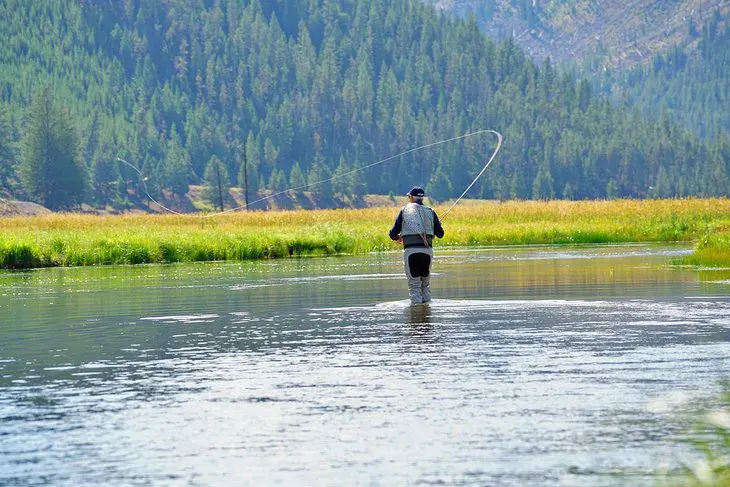
The Madison River is one of the best-known fly-fishing rivers in Montana. It’s a combination of intense scenic beauty, abundant access, and varied fishing conditions that makes it so great.
Though it’s farther than the Gallatin, its proximity to Bozeman also makes the Madison popular. Thousands of anglers from across the world fly into this university town to fish the warmer seasons.
The Madison River also starts within Yellowstone National Park, at the confluence of the Firehole and Gibbon Rivers. The river flows through the park for over 20 miles, where hikers can walk-and-wade into the hydrothermally heated waters. Early summer and fall are the best seasons to fly fish the Madison within the park.
Outside the park, the river collects at Hebgen Dam, a popular spot for still-water fishing. Beneath Hebgen, the river runs into Quake Lake, created by a 1959 massive earthquake and resulting rockslide that dammed the river. Intense rapids make up much of the section below Quake Lake, adding to its reputation as one of the best white water rivers in Montana.
After the water settles down beneath Quake Lake, the river stretches for over 50 miles through Madison Valley to Ennis. This section of the Madison is what drives international traffic. Also known as the “50-mile riffle,” it caters to both wade and float fishing.
3. Missouri River

Lewis and Clark placed the Missouri River into the history books of Montana. Today, anglers from across the world come to the same waterway for some of Montana’s best fly fishing. Montana’s capital city, Helena, is the largest city nearby and a common base camp for fly-fishing adventures on the Missouri.
The Missouri River spans over 700 miles through Montana. The length of the river makes it seem overwhelming to find the right spot to fish. But it’s the 30- to 40-mile stretch below Holter Dam that is the focus for most trout anglers. This famous section of the Missouri River is easily accessible from Craig, Montana, 40 miles north of Helena.
Access points to this section of the Missouri River are abundant off the adjacent Interstate 15. Trout fishing here is famous for a reason, and big hatches occur throughout the spring and into summer. Both wade fishing and float fishing are popular along this 30-mile stretch. Anglers should expect to see other anglers throughout the entirety of the warm weather season.
4. Yellowstone River
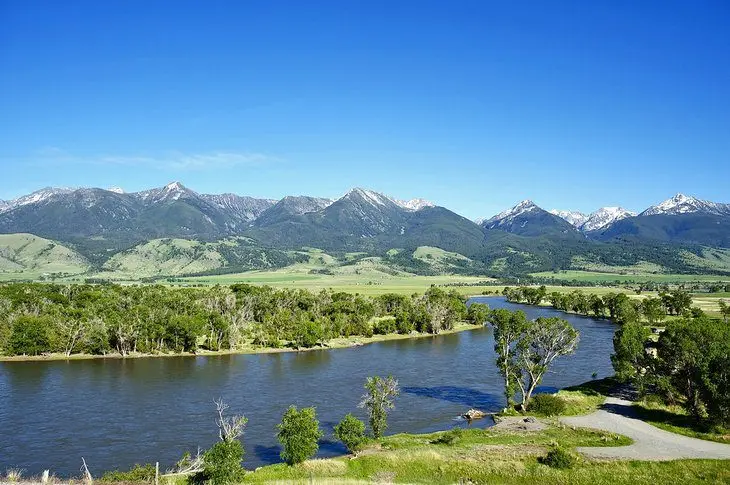
The Yellowstone River begins near Yellowstone Lake, one of the top attractions in Yellowstone National Park. From here, this near 700-mile river flows uninterrupted until it meets the Missouri River in North Dakota. The river is one of the longest free-flowing waterways in the country. And much of the waterway within Montana offers prime fly-fishing conditions.
The scenery surrounding the river is quintessential Montana. Outside the national park, the stretch of water between Gardiner and Livingston showcases this beautiful landscape. Visitors are quick to realize why this beautiful area of Montana is called Paradise Valley. This section of the river receives the most fishing pressure throughout the year.
Farther downstream, trout are pulled from the “Stone” all the way to Billings. Anglers looking to catch some solitude should cast a line anywhere beyond Livingston. While the river does receive a lot of pressure in general, abundant access and the sheer length of the river keeps the waterway uncrowded. While wade fishing is possible, the wide river is best floated.
Fly fishing the river in Yellowstone National Park is also popular but comes with more restrictions. Specifically, it’s all walk-and-wade, and no tubing or floating is allowed.
For anglers willing to make the hike, the Grand Canyon of the Yellowstone provides a productive fishery. This section of the river also provides one of the most beautiful canyon landscapes in the country.
5. Blackfoot River
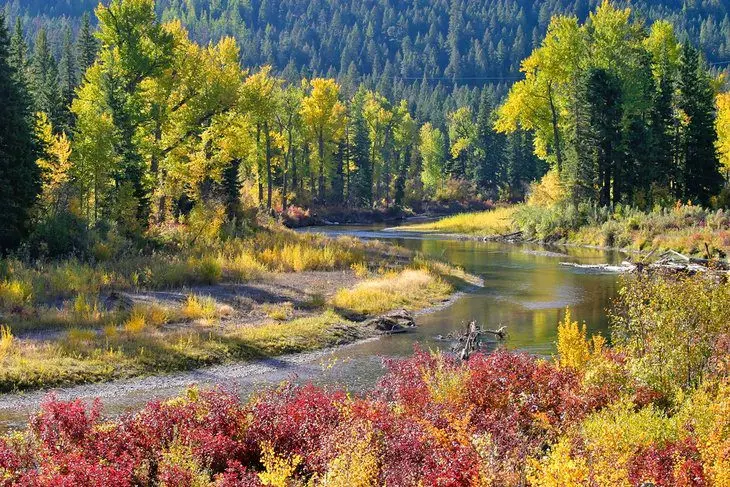
The Blackfoot River rose to fame thanks to the 1976 book, A River Runs Through It. The non-fiction novel led to a blockbuster motion picture of the same name in 1992. Some of this notoriety, as well as heavy opposition against a proposed gold mine, led to a revamped appreciation for the river. Today, thousands of locals, tourists, and trout make good use of the clean water.
The river winds for 130 miles from the Continental Divide to meet the Clark Fork River near Missoula. Near the university city, the river presents a dazzling scene, with mountain peaks jutting from the banks. Missoula makes for an excellent basecamp for fishing the Blackfoot, with other rivers also nearby, and plenty of local outfitters to guide the way.
Nearly the entire span has quality fishing, with abundant access points available off Highway 200 and Highway 141. A signature section of the river stretches from River Junction Fishing Access Site to Clearwater Crossing near Ovando. This stretch of river entices anglers with riffles, pools, and plenty of rainbow trout.
6. Big Hole River
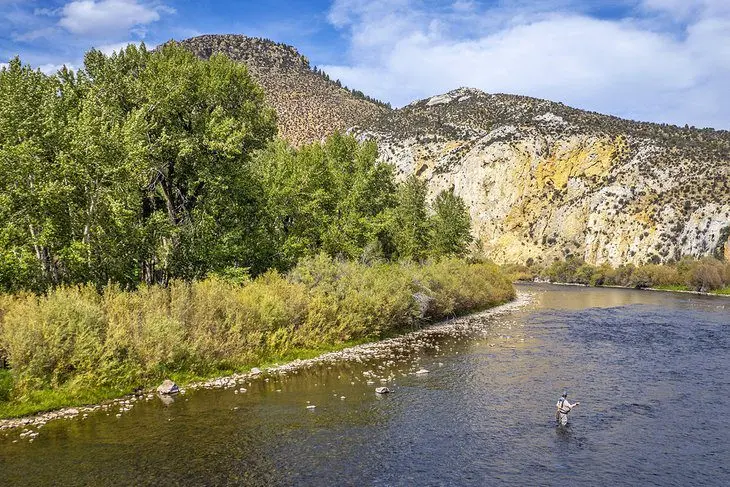
The Big Hole in the southwest part of Montana offers 150 miles of postcard Montana fly fishing. The river originates in the high elevations of the Bitterroot Mountains. It then flows through the picturesque Big Hole Valley, with big topography flanking all sides. Just visiting the Big Hole makes for a memorable fishing experience regardless of the catch.
Chances are, though, anglers are going to land something on the Big Hole River. A variety of big trout, including rainbow, brown, and cutthroat teem in this blue-ribbon river.
Ranging from high-mountain rock cliffs to rolling farmland, the Big Hole River presents a variety of landscapes. This change in scenery and river flow also provides visitors with a healthy mix of techniques to try.
Access to the Big Hole River is relatively easy. Highway 43 extends from Wisdom to beyond Wise River and parallels the waterway. The section of the river downstream from Wise River gives the Big Hole its excellent reputation.
7. Clark Fork River
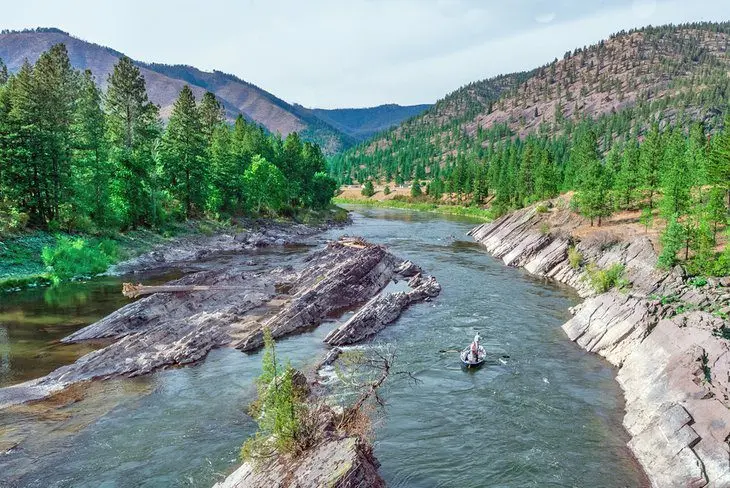
The Clark Fork River originates between Butte and Deer Lodge and flows along Interstate 90 past Missoula to the Idaho border. The river makes dramatic changes along its path, widening from a small stream to a large river by the time it reaches Missoula. This changing landscape affords several fly fishing opportunities.
Fishing access is abundant on the Clark Fork. Anglers often look at the river in two sections: the upper river above Missoula, and the lower river to the west. Anglers on the upper section should head to anywhere below where Rock Creek meets the Clark Fork. Streamers and dry flies tend to work best, with brown and rainbow trout waiting to bite.
The lower section of the Clark Fork picks up other major waterways, including the Flathead and Bitterroot Rivers. The extra water adds significant girth to the river. Below Missoula, float fishing is the most common and best way to go. Cutthroat are also known to swim in these waters.
The abundant trout in the Clark Fork is much in thanks to massive cleanup efforts on the river over the last decades. The productive mining region surrounding Butte had severe impacts on the river throughout the early 1900s. Today, the Clark Fork stands out as one of the best rivers in Montana.
8. Bitterroot River
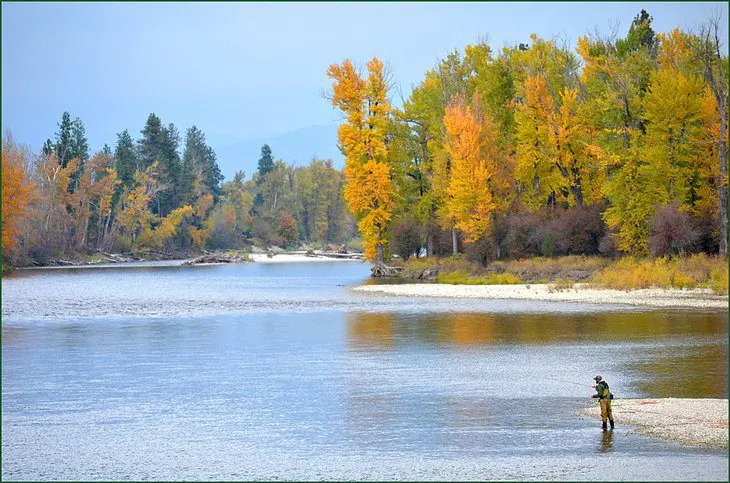
Surrounded by the Bitterroot Mountains to the west and the Sapphires to the east, the Bitterroot River offers textbook trout fishing. This big river that meanders in southwest Montana offers miles of desirable trout habitat filled with riffles and pools.
The Bitterroot River offers some of the earliest season fishing with a spring Skwala hatch. Anglers looking to imitate these unique stoneflies put fishing pressure on the river in spring. With several access points, though, the action is pretty well spread out.
Rainbow trout are the most abundant in the Bitterroot. Brown and cutthroats have also been pulled from the water. River pressure eases after the Skwala hatch in the spring, and the river provides excellent fishing throughout the summer and fall.
9. Rock Creek

Rock Creek is a classic trout stream flowing less than 30 minutes from Missoula – one of the best cities in Montana. This creek seems more like a river based on its size and provides a sanctuary for wade anglers. The river runs through Lolo National Forest for 30 miles, offering easy public access and gorgeous scenery.
The gravel Rock Creek Road that parallels the water also makes finding spots on the river easy. The shallow waters of Rock Creek have excellent trout habitats, including riffles, rock gardens, and deep pools. Wade anglers generally have access to both banks along the river, thanks to the shallow depths.
Rock Creek’s season spans much of the year outside of winter. A June salmonfly hatch always proves to be bountiful and puts the most fishing pressure on the river. A Golden Stone hatch follows and lasts through July.
10. Bighorn River
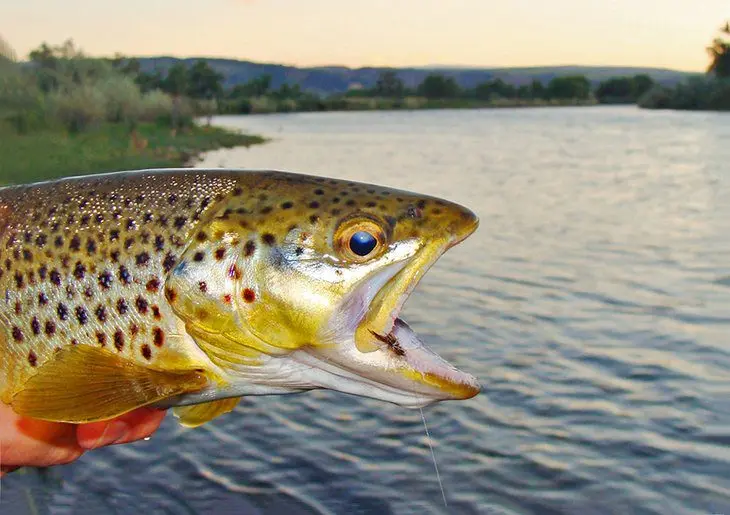
The Bighorn River, in south-central Montana, is one of the best trout streams in the country. Anglers come from across the world to land 16-inch rainbow and brown trout, which are in no short supply thanks to superb hatches.
This tailwater river is directly below Yellowtail Afterbay Dam within Bighorn Canyon National Recreation Area. The main point of interest for anglers is the 13 miles of river that flows downstream from the dam. This wild trout fishery flows through the Crow Indian Reservation. The river has been deemed public property, but the surrounding tribal lands are private, with no trespassing allowed.
While wade fishing is possible with low water levels, the section of the river below the dam swarms with boats throughout much of the year. And because of the calm waters regulated by the dam, a variety of fishing vessels take to the water. The summer season is the busiest on the Bighorn, and visitors shouldn’t be surprised to see a lot of anglers on the water.
The Bighorn River is also one of the rivers in the state to produce quality winter fishing. Anglers heading to the river between November and March need to prepare for potentially harsh conditions.
11. Sun River

The Sun River is born in the high elevations on the east side of the Bob Marshall Wilderness Complex. Challenging access and uncertain flows from irrigation dams lend to limited fishing pressure on the Sun River. These challenges deter many anglers, which lends to the trout biting at anything that drops in the water.
Once outside the wilderness complex, the river flows through the imposing Sun River Canyon. The steep landscape and rapids here make fishing more challenging, though rainbow, cutthroat, and brown trout teem in the turbulent water. Below Sun River Canyon, the river and fishing mellow out, with nice long riffles and runs.
Another excellent option is fly fishing on the South Fork or North Fork Sun River within the Bob Marshall Wilderness Complex. Because they are within a designated wilderness area, both require hike-in fishing. Surrounded by serene wilderness, and with dozens of bites per hour, these wild rivers provide an unforgettable Montana fishing experience.
12. Smith River
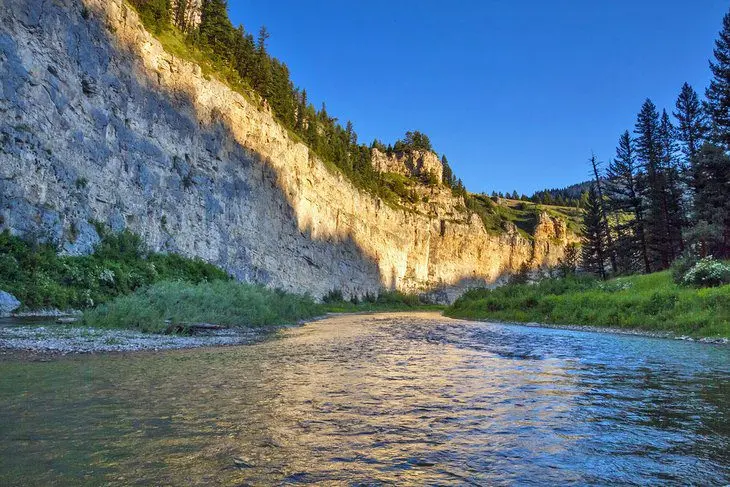
The Smith River offers magnificent Montana landscapes alongside fast striking fish. The river originates near White Sulphur Springs and travels approximately 100 miles before meeting the Missouri River. Much of the waterway passes through private land in this remote part of Montana, making fishing access a little more difficult.
What also makes fishing harder is that uniquely in the state, permits are required to float between public access points on the Smith River. These increasingly competitive permits are for the river’s most popular section, downstream from Camp Baker. While these permits are hard to get, the limited fishing pressure makes landing a fish easy on the Smith River.
The 60-mile section between Camp Baker and Eden Bridge is iconic fly fishing. The float usually takes four days to complete. Several designated campgrounds line the waterway. Anglers can expect sizable brown and rainbow trout.
Mid-May through June is an excellent time to vie for a permit when the best salmonfly hatch occurs.
13. Fly Fishing High Alpine Lakes
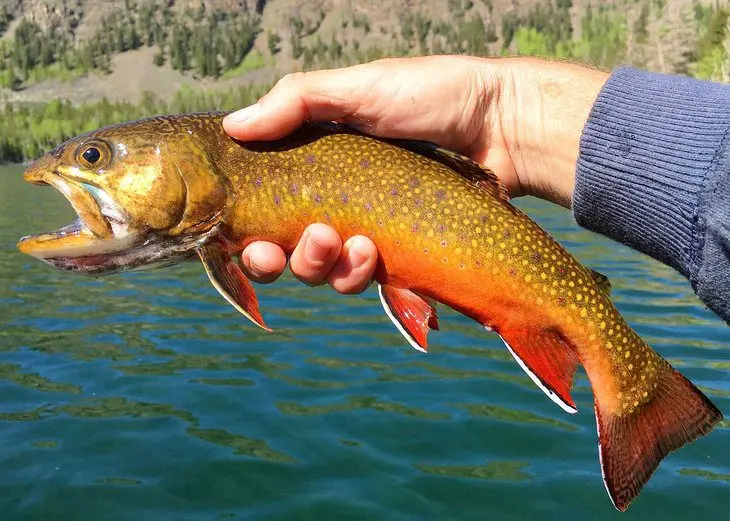
Montana’s elevated terrain provides surreal opportunities for stillwater fishing backdropped by mountain peaks. Don’t expect as big of a catch in Montana’s high alpine lakes, but you can bet on casting into a panoramic view. And because of the scarce pressure on the lakes, the fish are usually eager for a bite.
Thousands of alpine lakes dot the state of Montana. And places like the Absaroka-Beartooth Wilderness have hundreds of alpine lakes on their own. A great way to find the right one for your fishing needs is by consulting the fish stocking data at Montana Fish, Wildlife & Parks.
Half the adventure is sometimes simply reaching the alpine lake in Montana. These waters are also frigidly cold throughout the year. Be sure to gear up appropriately before fly fishing in a Montana alpine lake.










